Health Care Environment Report: Structure and Culture Analysis
VerifiedAdded on 2023/05/29
|12
|2441
|404
Report
AI Summary
This report analyzes the organizational structure and culture of a healthcare environment, specifically focusing on the "Road" scheme. The report begins with an executive summary, followed by an introduction outlining the importance of organizational structure. It then delves into the structure of the organization, identifying it as a Flatachry model, a hybrid of horizontal and vertical structures. The report then examines the organization's culture, identifying it as a task culture, where teams are formed to address specific problems. The impact of the organization's structure on its culture is then explored, highlighting how the structure supports collaboration and communication. Finally, the report proposes changes to improve the organization, suggesting granting autonomy to employees and providing training to enhance decision-making capabilities, ultimately aiming to reduce over-reliance on management and foster a more efficient and innovative environment.
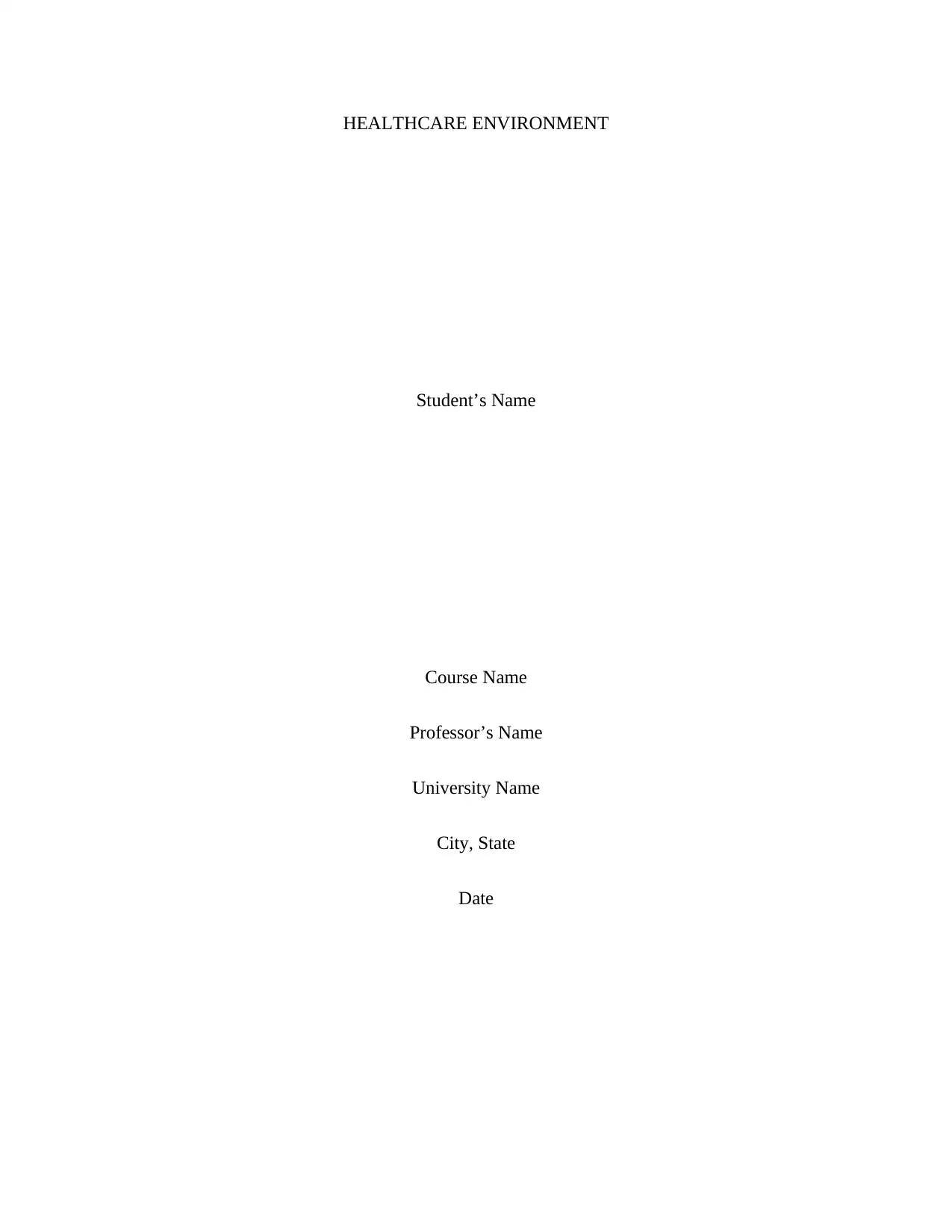
HEALTHCARE ENVIRONMENT
Student’s Name
Course Name
Professor’s Name
University Name
City, State
Date
Student’s Name
Course Name
Professor’s Name
University Name
City, State
Date
Paraphrase This Document
Need a fresh take? Get an instant paraphrase of this document with our AI Paraphraser
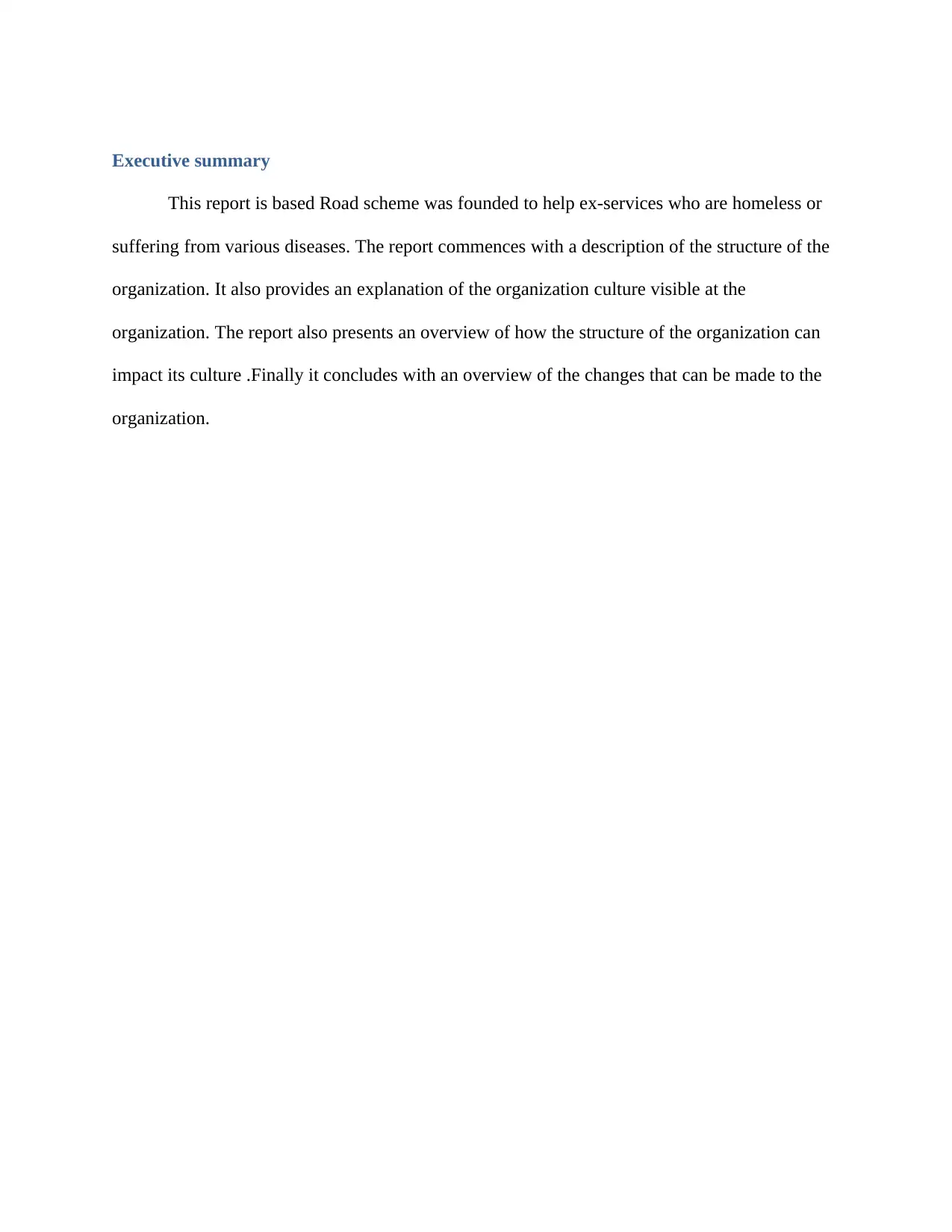
Executive summary
This report is based Road scheme was founded to help ex-services who are homeless or
suffering from various diseases. The report commences with a description of the structure of the
organization. It also provides an explanation of the organization culture visible at the
organization. The report also presents an overview of how the structure of the organization can
impact its culture .Finally it concludes with an overview of the changes that can be made to the
organization.
This report is based Road scheme was founded to help ex-services who are homeless or
suffering from various diseases. The report commences with a description of the structure of the
organization. It also provides an explanation of the organization culture visible at the
organization. The report also presents an overview of how the structure of the organization can
impact its culture .Finally it concludes with an overview of the changes that can be made to the
organization.
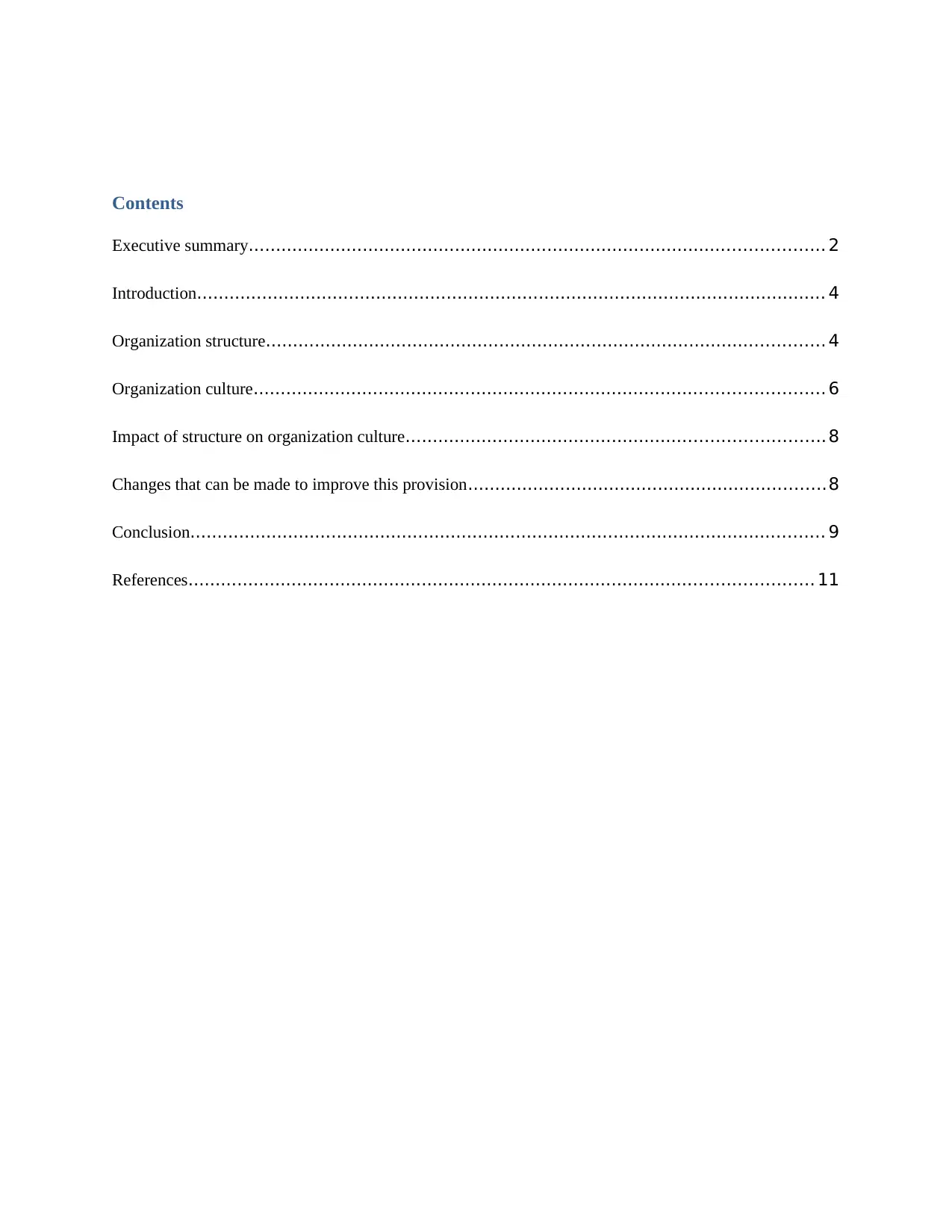
Contents
Executive summary.......................................................................................................... 2
Introduction.................................................................................................................... 4
Organization structure....................................................................................................... 4
Organization culture......................................................................................................... 6
Impact of structure on organization culture............................................................................. 8
Changes that can be made to improve this provision..................................................................8
Conclusion..................................................................................................................... 9
References................................................................................................................... 11
Executive summary.......................................................................................................... 2
Introduction.................................................................................................................... 4
Organization structure....................................................................................................... 4
Organization culture......................................................................................................... 6
Impact of structure on organization culture............................................................................. 8
Changes that can be made to improve this provision..................................................................8
Conclusion..................................................................................................................... 9
References................................................................................................................... 11
⊘ This is a preview!⊘
Do you want full access?
Subscribe today to unlock all pages.

Trusted by 1+ million students worldwide
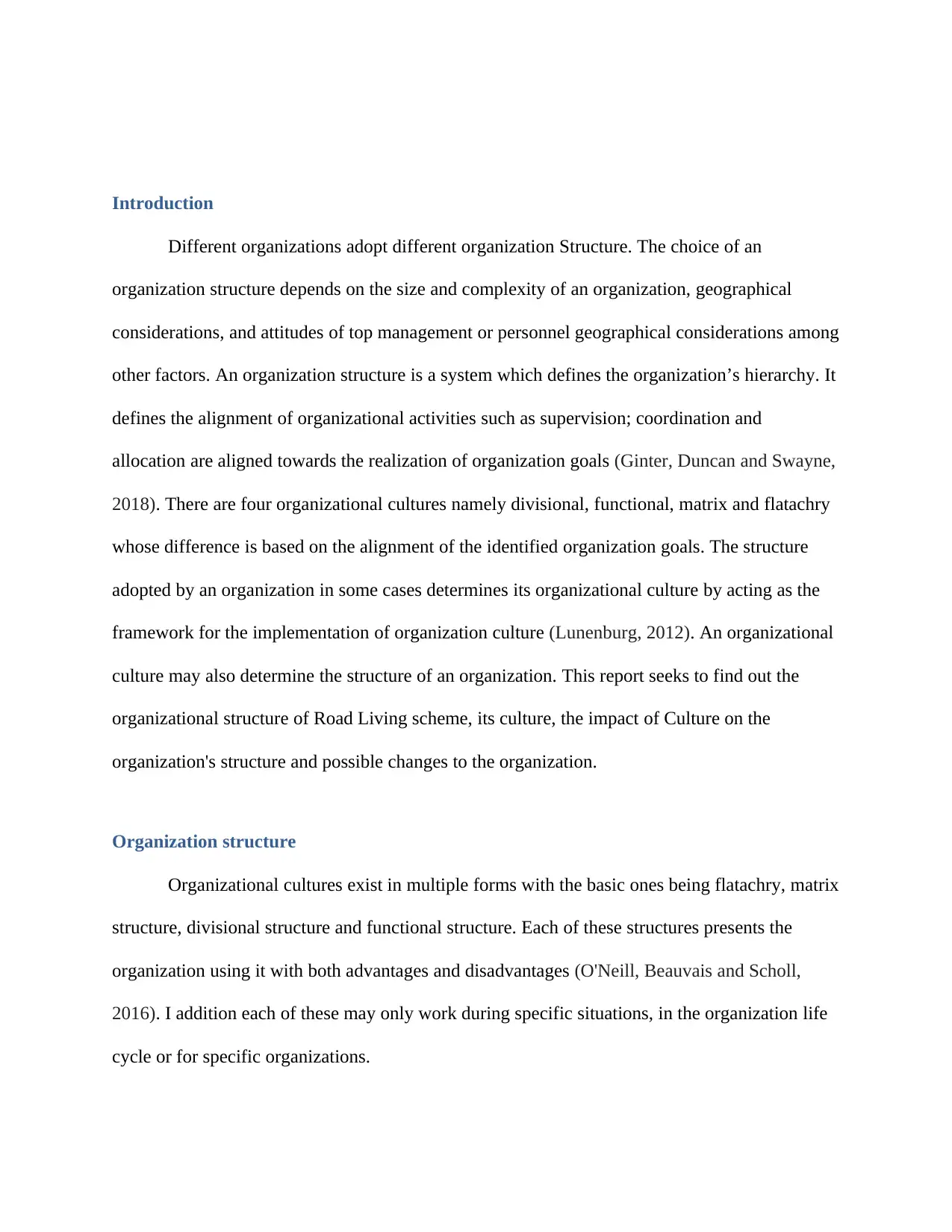
Introduction
Different organizations adopt different organization Structure. The choice of an
organization structure depends on the size and complexity of an organization, geographical
considerations, and attitudes of top management or personnel geographical considerations among
other factors. An organization structure is a system which defines the organization’s hierarchy. It
defines the alignment of organizational activities such as supervision; coordination and
allocation are aligned towards the realization of organization goals (Ginter, Duncan and Swayne,
2018). There are four organizational cultures namely divisional, functional, matrix and flatachry
whose difference is based on the alignment of the identified organization goals. The structure
adopted by an organization in some cases determines its organizational culture by acting as the
framework for the implementation of organization culture (Lunenburg, 2012). An organizational
culture may also determine the structure of an organization. This report seeks to find out the
organizational structure of Road Living scheme, its culture, the impact of Culture on the
organization's structure and possible changes to the organization.
Organization structure
Organizational cultures exist in multiple forms with the basic ones being flatachry, matrix
structure, divisional structure and functional structure. Each of these structures presents the
organization using it with both advantages and disadvantages (O'Neill, Beauvais and Scholl,
2016). I addition each of these may only work during specific situations, in the organization life
cycle or for specific organizations.
Different organizations adopt different organization Structure. The choice of an
organization structure depends on the size and complexity of an organization, geographical
considerations, and attitudes of top management or personnel geographical considerations among
other factors. An organization structure is a system which defines the organization’s hierarchy. It
defines the alignment of organizational activities such as supervision; coordination and
allocation are aligned towards the realization of organization goals (Ginter, Duncan and Swayne,
2018). There are four organizational cultures namely divisional, functional, matrix and flatachry
whose difference is based on the alignment of the identified organization goals. The structure
adopted by an organization in some cases determines its organizational culture by acting as the
framework for the implementation of organization culture (Lunenburg, 2012). An organizational
culture may also determine the structure of an organization. This report seeks to find out the
organizational structure of Road Living scheme, its culture, the impact of Culture on the
organization's structure and possible changes to the organization.
Organization structure
Organizational cultures exist in multiple forms with the basic ones being flatachry, matrix
structure, divisional structure and functional structure. Each of these structures presents the
organization using it with both advantages and disadvantages (O'Neill, Beauvais and Scholl,
2016). I addition each of these may only work during specific situations, in the organization life
cycle or for specific organizations.
Paraphrase This Document
Need a fresh take? Get an instant paraphrase of this document with our AI Paraphraser
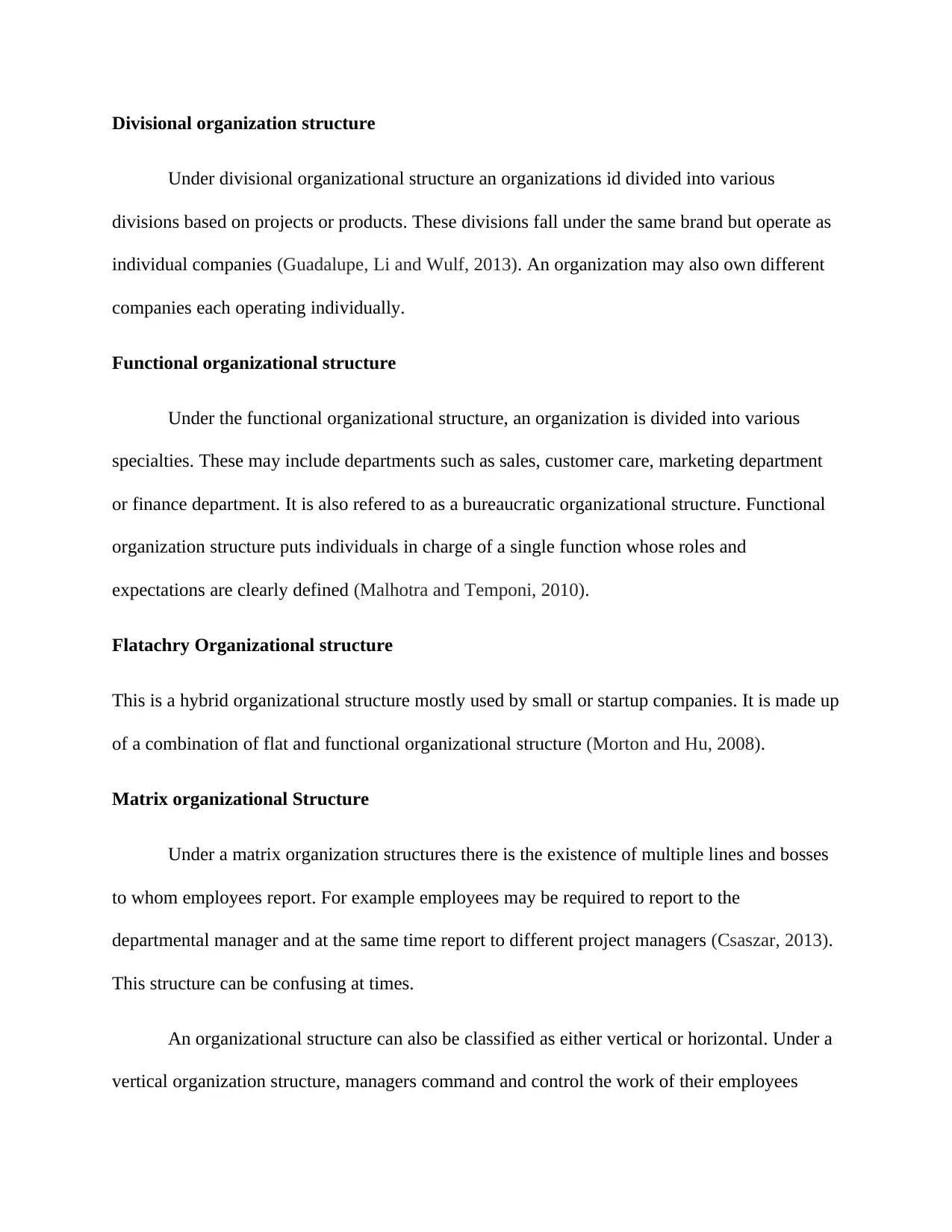
Divisional organization structure
Under divisional organizational structure an organizations id divided into various
divisions based on projects or products. These divisions fall under the same brand but operate as
individual companies (Guadalupe, Li and Wulf, 2013). An organization may also own different
companies each operating individually.
Functional organizational structure
Under the functional organizational structure, an organization is divided into various
specialties. These may include departments such as sales, customer care, marketing department
or finance department. It is also refered to as a bureaucratic organizational structure. Functional
organization structure puts individuals in charge of a single function whose roles and
expectations are clearly defined (Malhotra and Temponi, 2010).
Flatachry Organizational structure
This is a hybrid organizational structure mostly used by small or startup companies. It is made up
of a combination of flat and functional organizational structure (Morton and Hu, 2008).
Matrix organizational Structure
Under a matrix organization structures there is the existence of multiple lines and bosses
to whom employees report. For example employees may be required to report to the
departmental manager and at the same time report to different project managers (Csaszar, 2013).
This structure can be confusing at times.
An organizational structure can also be classified as either vertical or horizontal. Under a
vertical organization structure, managers command and control the work of their employees
Under divisional organizational structure an organizations id divided into various
divisions based on projects or products. These divisions fall under the same brand but operate as
individual companies (Guadalupe, Li and Wulf, 2013). An organization may also own different
companies each operating individually.
Functional organizational structure
Under the functional organizational structure, an organization is divided into various
specialties. These may include departments such as sales, customer care, marketing department
or finance department. It is also refered to as a bureaucratic organizational structure. Functional
organization structure puts individuals in charge of a single function whose roles and
expectations are clearly defined (Malhotra and Temponi, 2010).
Flatachry Organizational structure
This is a hybrid organizational structure mostly used by small or startup companies. It is made up
of a combination of flat and functional organizational structure (Morton and Hu, 2008).
Matrix organizational Structure
Under a matrix organization structures there is the existence of multiple lines and bosses
to whom employees report. For example employees may be required to report to the
departmental manager and at the same time report to different project managers (Csaszar, 2013).
This structure can be confusing at times.
An organizational structure can also be classified as either vertical or horizontal. Under a
vertical organization structure, managers command and control the work of their employees
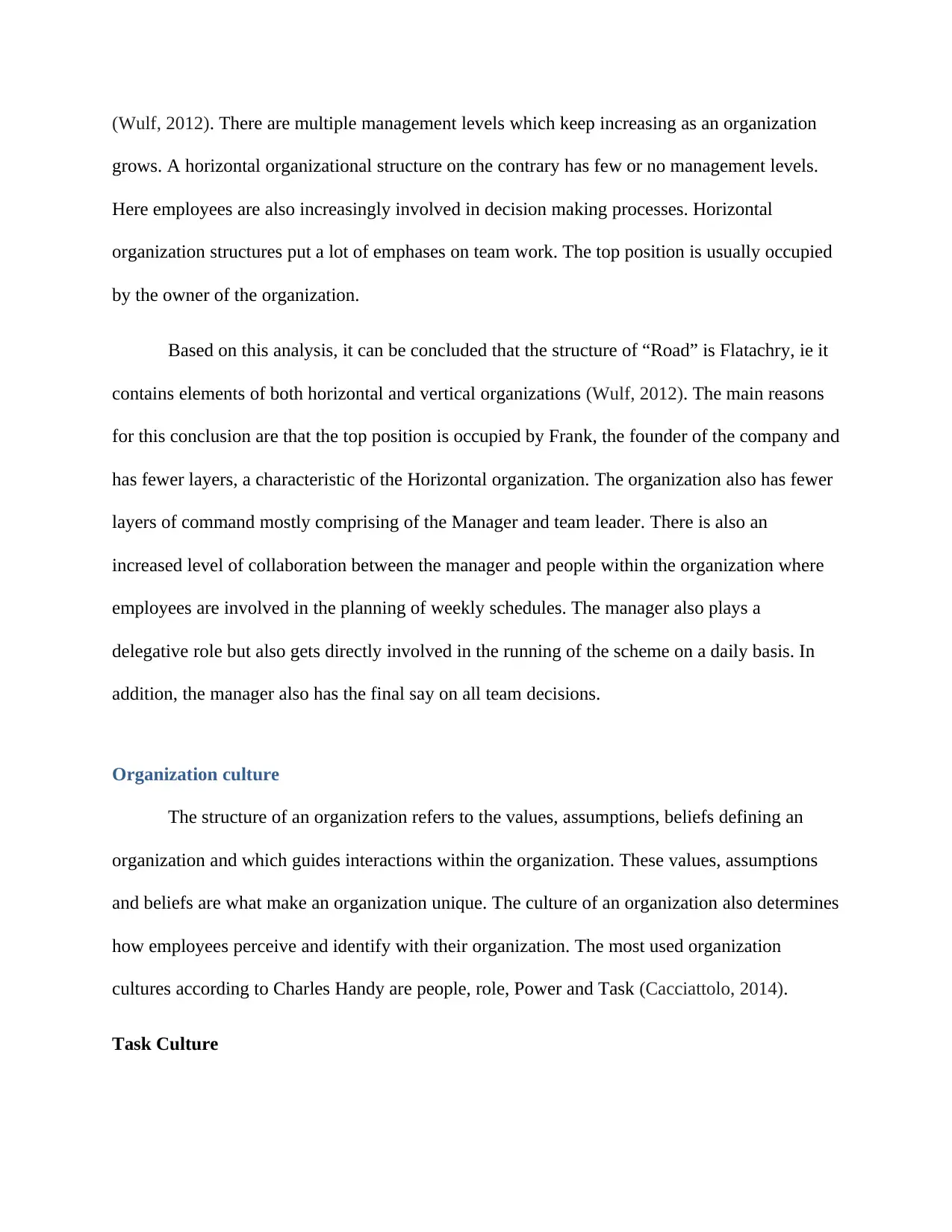
(Wulf, 2012). There are multiple management levels which keep increasing as an organization
grows. A horizontal organizational structure on the contrary has few or no management levels.
Here employees are also increasingly involved in decision making processes. Horizontal
organization structures put a lot of emphases on team work. The top position is usually occupied
by the owner of the organization.
Based on this analysis, it can be concluded that the structure of “Road” is Flatachry, ie it
contains elements of both horizontal and vertical organizations (Wulf, 2012). The main reasons
for this conclusion are that the top position is occupied by Frank, the founder of the company and
has fewer layers, a characteristic of the Horizontal organization. The organization also has fewer
layers of command mostly comprising of the Manager and team leader. There is also an
increased level of collaboration between the manager and people within the organization where
employees are involved in the planning of weekly schedules. The manager also plays a
delegative role but also gets directly involved in the running of the scheme on a daily basis. In
addition, the manager also has the final say on all team decisions.
Organization culture
The structure of an organization refers to the values, assumptions, beliefs defining an
organization and which guides interactions within the organization. These values, assumptions
and beliefs are what make an organization unique. The culture of an organization also determines
how employees perceive and identify with their organization. The most used organization
cultures according to Charles Handy are people, role, Power and Task (Cacciattolo, 2014).
Task Culture
grows. A horizontal organizational structure on the contrary has few or no management levels.
Here employees are also increasingly involved in decision making processes. Horizontal
organization structures put a lot of emphases on team work. The top position is usually occupied
by the owner of the organization.
Based on this analysis, it can be concluded that the structure of “Road” is Flatachry, ie it
contains elements of both horizontal and vertical organizations (Wulf, 2012). The main reasons
for this conclusion are that the top position is occupied by Frank, the founder of the company and
has fewer layers, a characteristic of the Horizontal organization. The organization also has fewer
layers of command mostly comprising of the Manager and team leader. There is also an
increased level of collaboration between the manager and people within the organization where
employees are involved in the planning of weekly schedules. The manager also plays a
delegative role but also gets directly involved in the running of the scheme on a daily basis. In
addition, the manager also has the final say on all team decisions.
Organization culture
The structure of an organization refers to the values, assumptions, beliefs defining an
organization and which guides interactions within the organization. These values, assumptions
and beliefs are what make an organization unique. The culture of an organization also determines
how employees perceive and identify with their organization. The most used organization
cultures according to Charles Handy are people, role, Power and Task (Cacciattolo, 2014).
Task Culture
⊘ This is a preview!⊘
Do you want full access?
Subscribe today to unlock all pages.

Trusted by 1+ million students worldwide
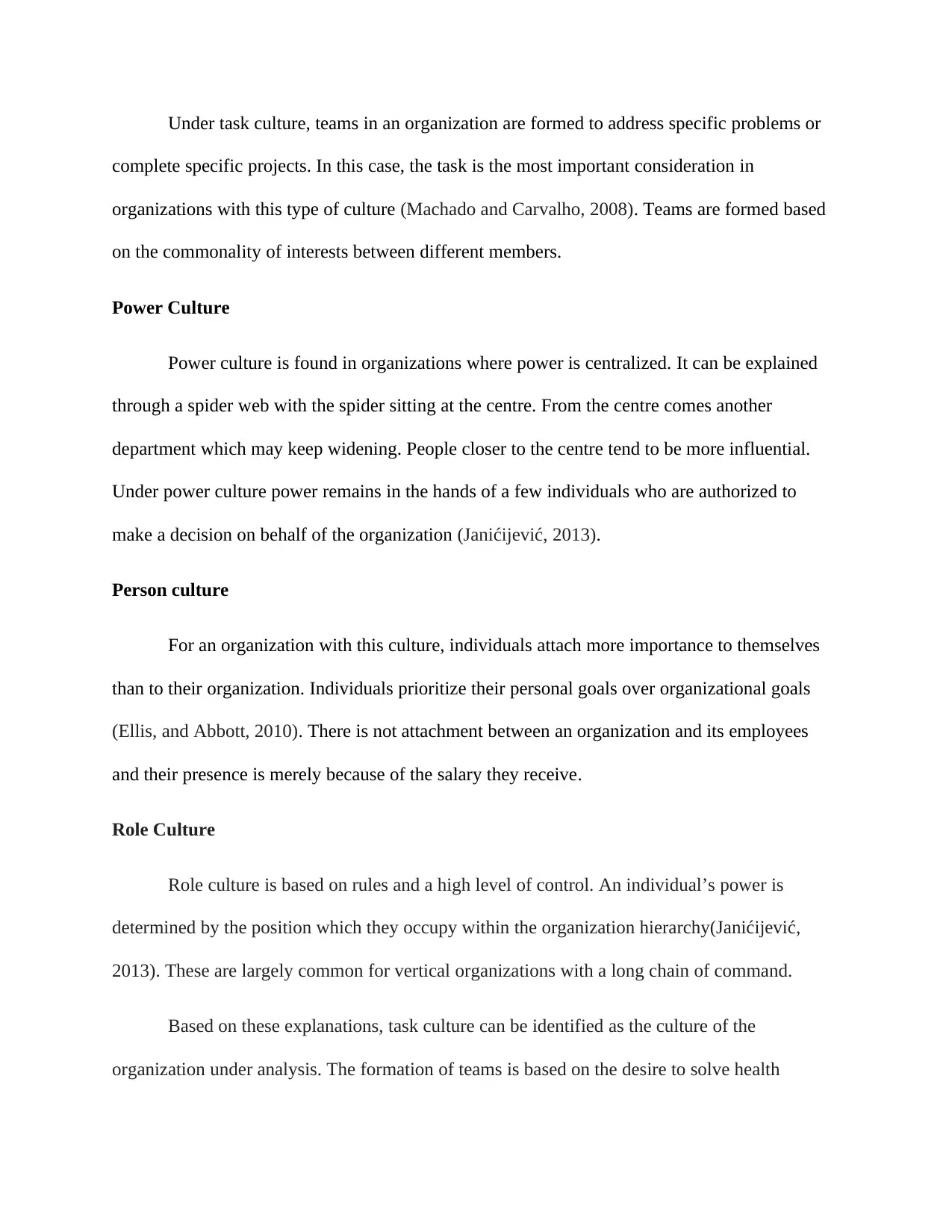
Under task culture, teams in an organization are formed to address specific problems or
complete specific projects. In this case, the task is the most important consideration in
organizations with this type of culture (Machado and Carvalho, 2008). Teams are formed based
on the commonality of interests between different members.
Power Culture
Power culture is found in organizations where power is centralized. It can be explained
through a spider web with the spider sitting at the centre. From the centre comes another
department which may keep widening. People closer to the centre tend to be more influential.
Under power culture power remains in the hands of a few individuals who are authorized to
make a decision on behalf of the organization (Janićijević, 2013).
Person culture
For an organization with this culture, individuals attach more importance to themselves
than to their organization. Individuals prioritize their personal goals over organizational goals
(Ellis, and Abbott, 2010). There is not attachment between an organization and its employees
and their presence is merely because of the salary they receive.
Role Culture
Role culture is based on rules and a high level of control. An individual’s power is
determined by the position which they occupy within the organization hierarchy(Janićijević,
2013). These are largely common for vertical organizations with a long chain of command.
Based on these explanations, task culture can be identified as the culture of the
organization under analysis. The formation of teams is based on the desire to solve health
complete specific projects. In this case, the task is the most important consideration in
organizations with this type of culture (Machado and Carvalho, 2008). Teams are formed based
on the commonality of interests between different members.
Power Culture
Power culture is found in organizations where power is centralized. It can be explained
through a spider web with the spider sitting at the centre. From the centre comes another
department which may keep widening. People closer to the centre tend to be more influential.
Under power culture power remains in the hands of a few individuals who are authorized to
make a decision on behalf of the organization (Janićijević, 2013).
Person culture
For an organization with this culture, individuals attach more importance to themselves
than to their organization. Individuals prioritize their personal goals over organizational goals
(Ellis, and Abbott, 2010). There is not attachment between an organization and its employees
and their presence is merely because of the salary they receive.
Role Culture
Role culture is based on rules and a high level of control. An individual’s power is
determined by the position which they occupy within the organization hierarchy(Janićijević,
2013). These are largely common for vertical organizations with a long chain of command.
Based on these explanations, task culture can be identified as the culture of the
organization under analysis. The formation of teams is based on the desire to solve health
Paraphrase This Document
Need a fresh take? Get an instant paraphrase of this document with our AI Paraphraser
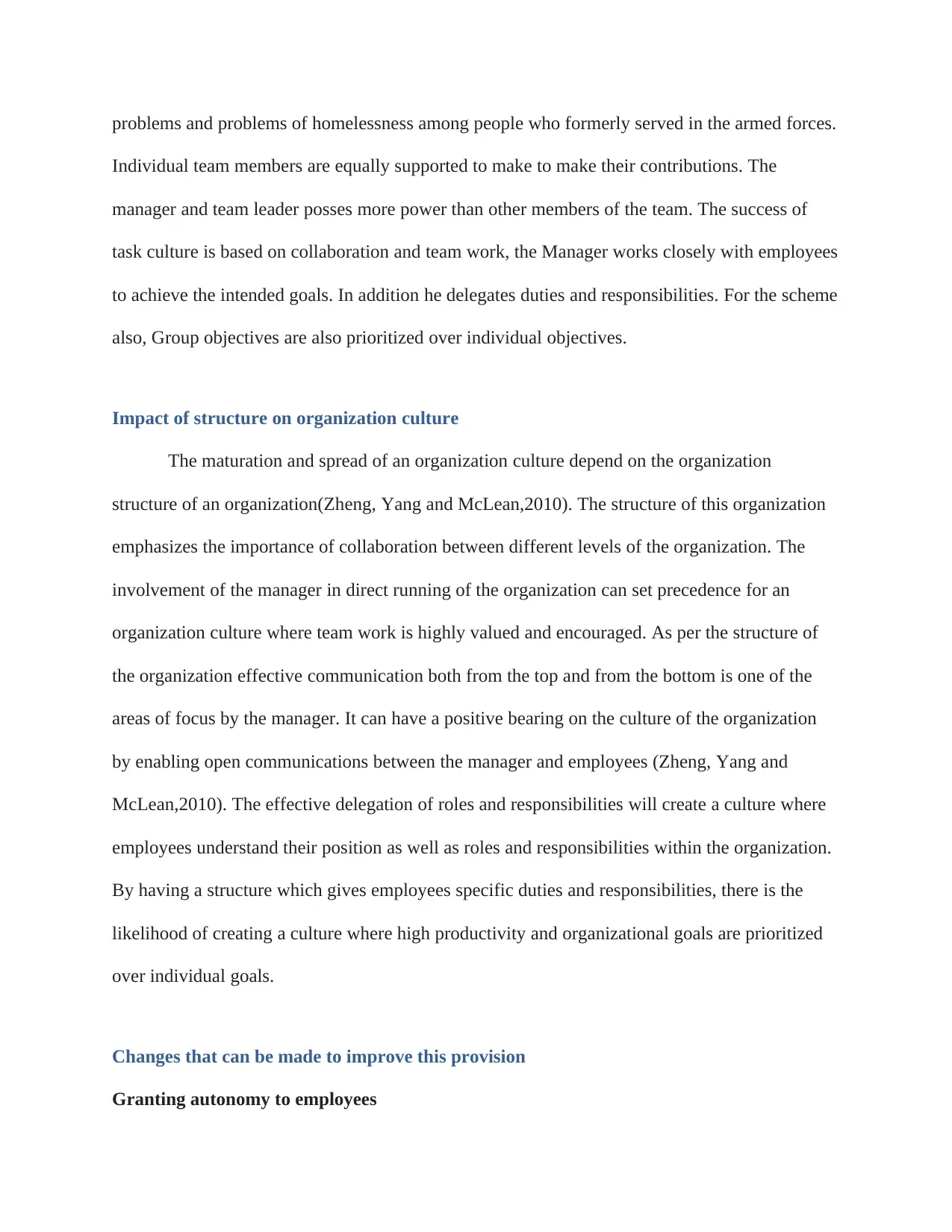
problems and problems of homelessness among people who formerly served in the armed forces.
Individual team members are equally supported to make to make their contributions. The
manager and team leader posses more power than other members of the team. The success of
task culture is based on collaboration and team work, the Manager works closely with employees
to achieve the intended goals. In addition he delegates duties and responsibilities. For the scheme
also, Group objectives are also prioritized over individual objectives.
Impact of structure on organization culture
The maturation and spread of an organization culture depend on the organization
structure of an organization(Zheng, Yang and McLean,2010). The structure of this organization
emphasizes the importance of collaboration between different levels of the organization. The
involvement of the manager in direct running of the organization can set precedence for an
organization culture where team work is highly valued and encouraged. As per the structure of
the organization effective communication both from the top and from the bottom is one of the
areas of focus by the manager. It can have a positive bearing on the culture of the organization
by enabling open communications between the manager and employees (Zheng, Yang and
McLean,2010). The effective delegation of roles and responsibilities will create a culture where
employees understand their position as well as roles and responsibilities within the organization.
By having a structure which gives employees specific duties and responsibilities, there is the
likelihood of creating a culture where high productivity and organizational goals are prioritized
over individual goals.
Changes that can be made to improve this provision
Granting autonomy to employees
Individual team members are equally supported to make to make their contributions. The
manager and team leader posses more power than other members of the team. The success of
task culture is based on collaboration and team work, the Manager works closely with employees
to achieve the intended goals. In addition he delegates duties and responsibilities. For the scheme
also, Group objectives are also prioritized over individual objectives.
Impact of structure on organization culture
The maturation and spread of an organization culture depend on the organization
structure of an organization(Zheng, Yang and McLean,2010). The structure of this organization
emphasizes the importance of collaboration between different levels of the organization. The
involvement of the manager in direct running of the organization can set precedence for an
organization culture where team work is highly valued and encouraged. As per the structure of
the organization effective communication both from the top and from the bottom is one of the
areas of focus by the manager. It can have a positive bearing on the culture of the organization
by enabling open communications between the manager and employees (Zheng, Yang and
McLean,2010). The effective delegation of roles and responsibilities will create a culture where
employees understand their position as well as roles and responsibilities within the organization.
By having a structure which gives employees specific duties and responsibilities, there is the
likelihood of creating a culture where high productivity and organizational goals are prioritized
over individual goals.
Changes that can be made to improve this provision
Granting autonomy to employees
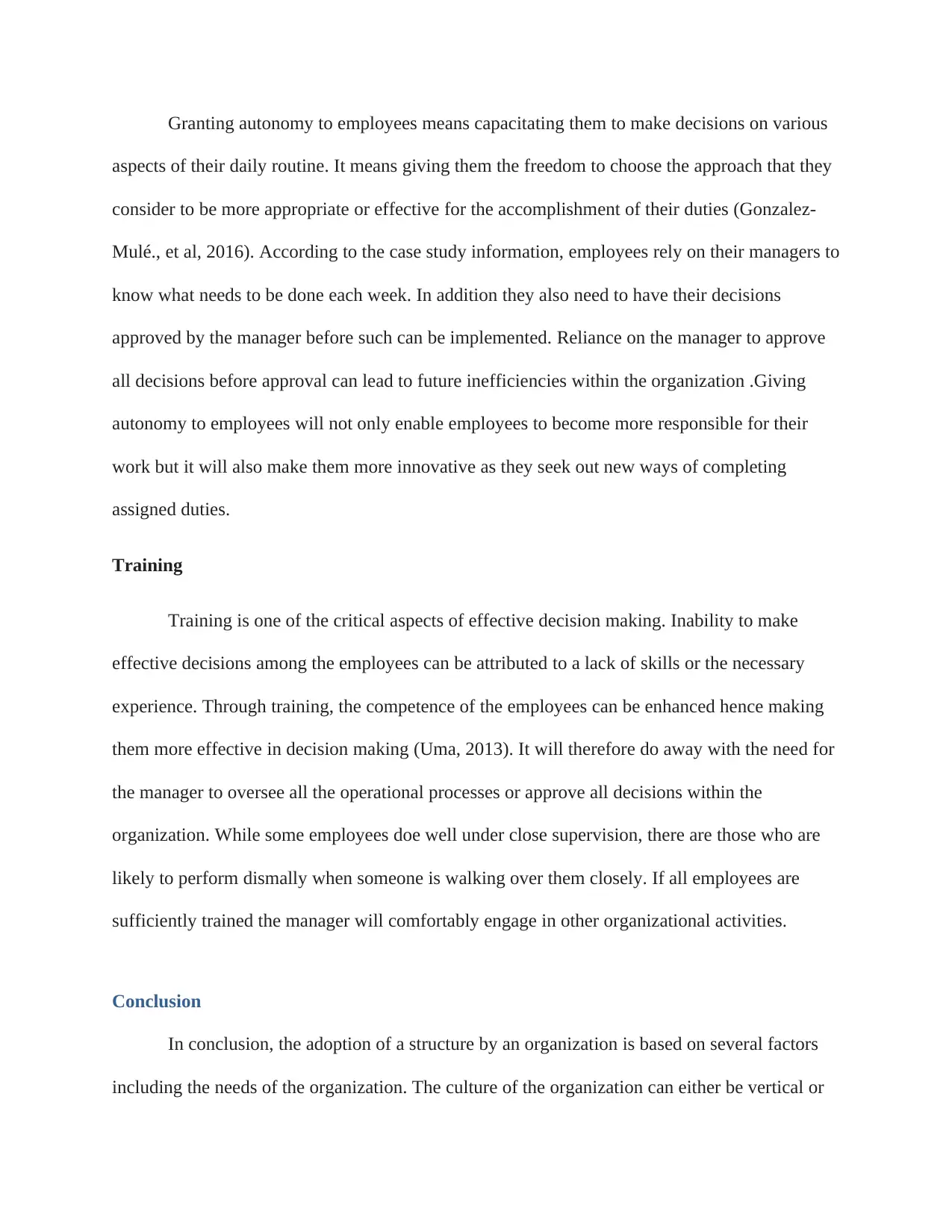
Granting autonomy to employees means capacitating them to make decisions on various
aspects of their daily routine. It means giving them the freedom to choose the approach that they
consider to be more appropriate or effective for the accomplishment of their duties (Gonzalez-
Mulé., et al, 2016). According to the case study information, employees rely on their managers to
know what needs to be done each week. In addition they also need to have their decisions
approved by the manager before such can be implemented. Reliance on the manager to approve
all decisions before approval can lead to future inefficiencies within the organization .Giving
autonomy to employees will not only enable employees to become more responsible for their
work but it will also make them more innovative as they seek out new ways of completing
assigned duties.
Training
Training is one of the critical aspects of effective decision making. Inability to make
effective decisions among the employees can be attributed to a lack of skills or the necessary
experience. Through training, the competence of the employees can be enhanced hence making
them more effective in decision making (Uma, 2013). It will therefore do away with the need for
the manager to oversee all the operational processes or approve all decisions within the
organization. While some employees doe well under close supervision, there are those who are
likely to perform dismally when someone is walking over them closely. If all employees are
sufficiently trained the manager will comfortably engage in other organizational activities.
Conclusion
In conclusion, the adoption of a structure by an organization is based on several factors
including the needs of the organization. The culture of the organization can either be vertical or
aspects of their daily routine. It means giving them the freedom to choose the approach that they
consider to be more appropriate or effective for the accomplishment of their duties (Gonzalez-
Mulé., et al, 2016). According to the case study information, employees rely on their managers to
know what needs to be done each week. In addition they also need to have their decisions
approved by the manager before such can be implemented. Reliance on the manager to approve
all decisions before approval can lead to future inefficiencies within the organization .Giving
autonomy to employees will not only enable employees to become more responsible for their
work but it will also make them more innovative as they seek out new ways of completing
assigned duties.
Training
Training is one of the critical aspects of effective decision making. Inability to make
effective decisions among the employees can be attributed to a lack of skills or the necessary
experience. Through training, the competence of the employees can be enhanced hence making
them more effective in decision making (Uma, 2013). It will therefore do away with the need for
the manager to oversee all the operational processes or approve all decisions within the
organization. While some employees doe well under close supervision, there are those who are
likely to perform dismally when someone is walking over them closely. If all employees are
sufficiently trained the manager will comfortably engage in other organizational activities.
Conclusion
In conclusion, the adoption of a structure by an organization is based on several factors
including the needs of the organization. The culture of the organization can either be vertical or
⊘ This is a preview!⊘
Do you want full access?
Subscribe today to unlock all pages.

Trusted by 1+ million students worldwide
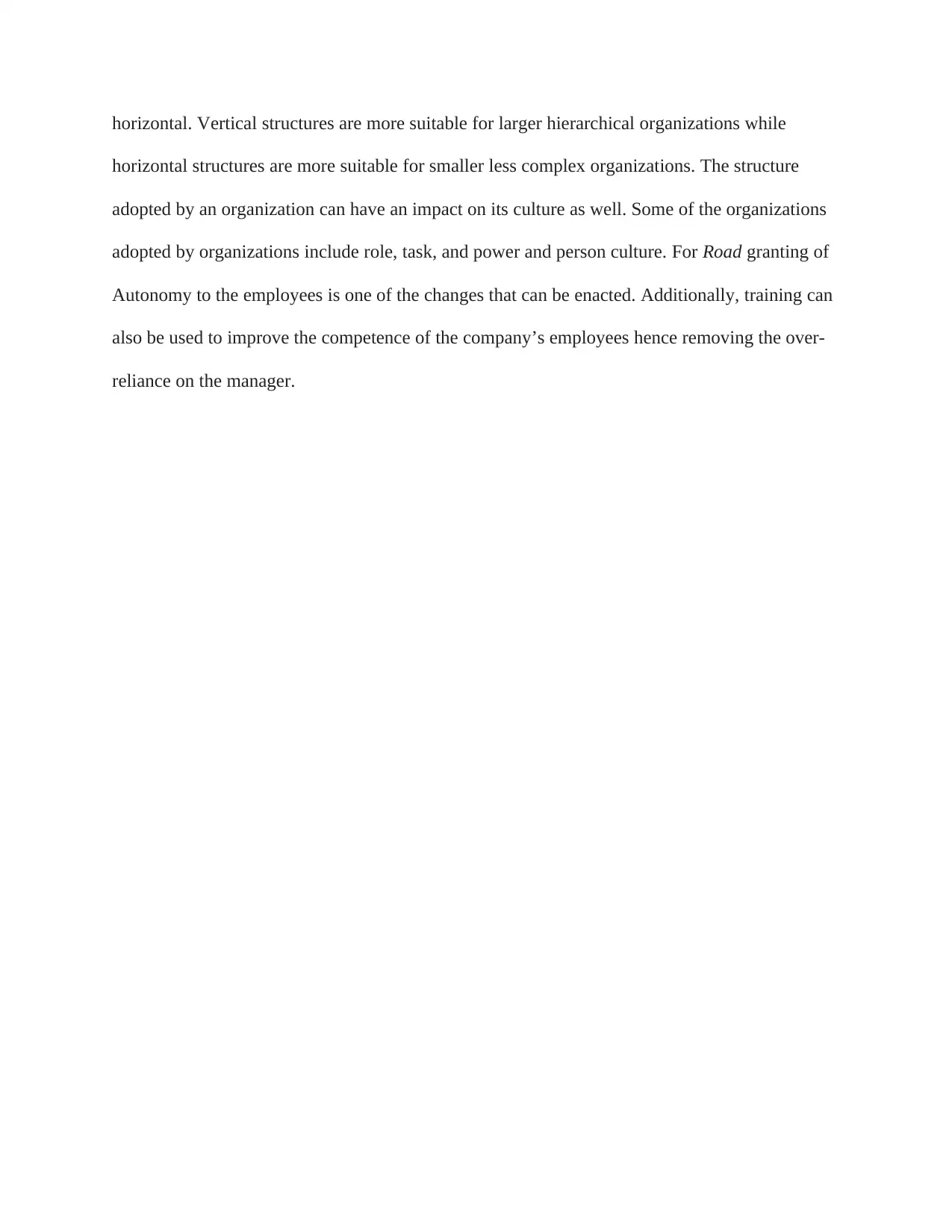
horizontal. Vertical structures are more suitable for larger hierarchical organizations while
horizontal structures are more suitable for smaller less complex organizations. The structure
adopted by an organization can have an impact on its culture as well. Some of the organizations
adopted by organizations include role, task, and power and person culture. For Road granting of
Autonomy to the employees is one of the changes that can be enacted. Additionally, training can
also be used to improve the competence of the company’s employees hence removing the over-
reliance on the manager.
horizontal structures are more suitable for smaller less complex organizations. The structure
adopted by an organization can have an impact on its culture as well. Some of the organizations
adopted by organizations include role, task, and power and person culture. For Road granting of
Autonomy to the employees is one of the changes that can be enacted. Additionally, training can
also be used to improve the competence of the company’s employees hence removing the over-
reliance on the manager.
Paraphrase This Document
Need a fresh take? Get an instant paraphrase of this document with our AI Paraphraser
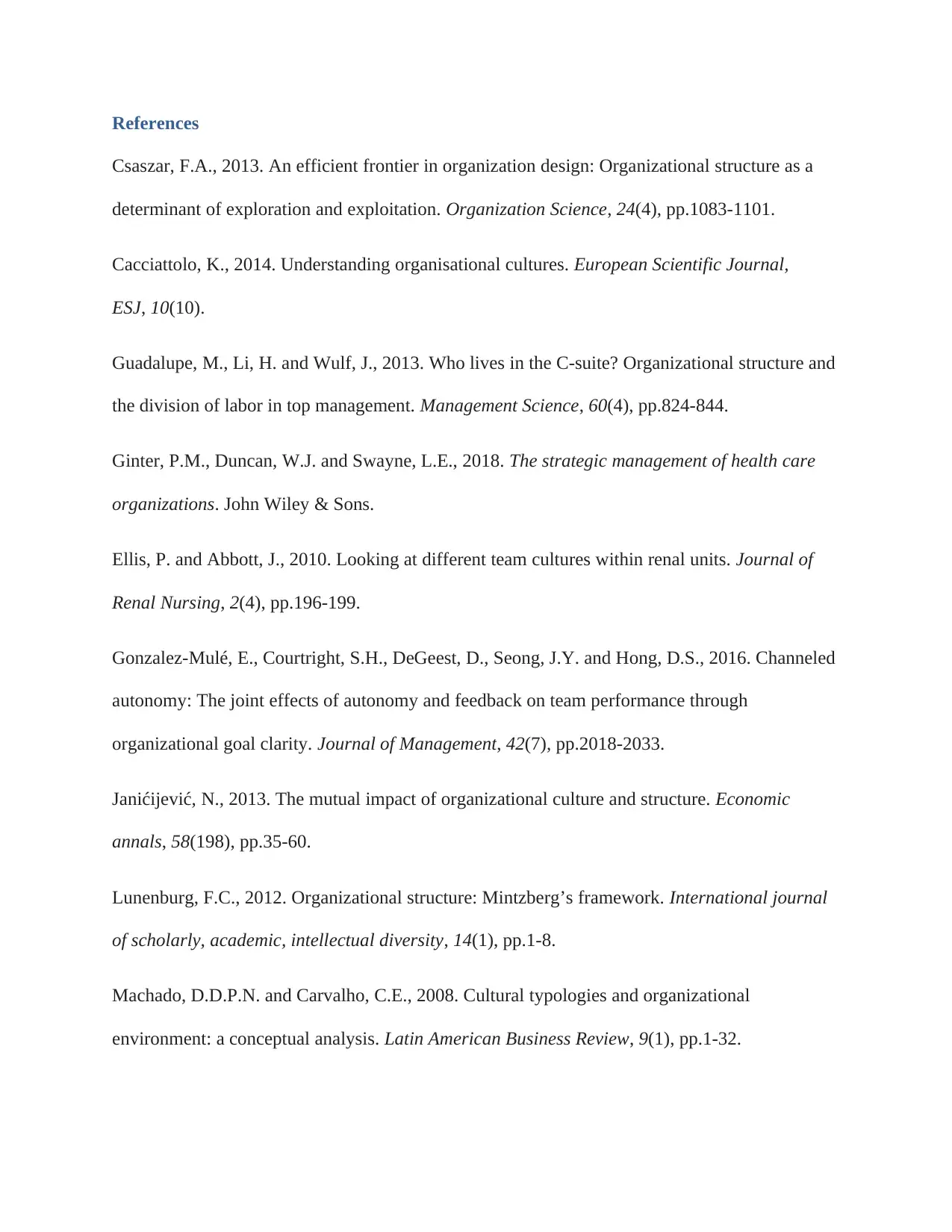
References
Csaszar, F.A., 2013. An efficient frontier in organization design: Organizational structure as a
determinant of exploration and exploitation. Organization Science, 24(4), pp.1083-1101.
Cacciattolo, K., 2014. Understanding organisational cultures. European Scientific Journal,
ESJ, 10(10).
Guadalupe, M., Li, H. and Wulf, J., 2013. Who lives in the C-suite? Organizational structure and
the division of labor in top management. Management Science, 60(4), pp.824-844.
Ginter, P.M., Duncan, W.J. and Swayne, L.E., 2018. The strategic management of health care
organizations. John Wiley & Sons.
Ellis, P. and Abbott, J., 2010. Looking at different team cultures within renal units. Journal of
Renal Nursing, 2(4), pp.196-199.
Gonzalez-Mulé, E., Courtright, S.H., DeGeest, D., Seong, J.Y. and Hong, D.S., 2016. Channeled
autonomy: The joint effects of autonomy and feedback on team performance through
organizational goal clarity. Journal of Management, 42(7), pp.2018-2033.
Janićijević, N., 2013. The mutual impact of organizational culture and structure. Economic
annals, 58(198), pp.35-60.
Lunenburg, F.C., 2012. Organizational structure: Mintzberg’s framework. International journal
of scholarly, academic, intellectual diversity, 14(1), pp.1-8.
Machado, D.D.P.N. and Carvalho, C.E., 2008. Cultural typologies and organizational
environment: a conceptual analysis. Latin American Business Review, 9(1), pp.1-32.
Csaszar, F.A., 2013. An efficient frontier in organization design: Organizational structure as a
determinant of exploration and exploitation. Organization Science, 24(4), pp.1083-1101.
Cacciattolo, K., 2014. Understanding organisational cultures. European Scientific Journal,
ESJ, 10(10).
Guadalupe, M., Li, H. and Wulf, J., 2013. Who lives in the C-suite? Organizational structure and
the division of labor in top management. Management Science, 60(4), pp.824-844.
Ginter, P.M., Duncan, W.J. and Swayne, L.E., 2018. The strategic management of health care
organizations. John Wiley & Sons.
Ellis, P. and Abbott, J., 2010. Looking at different team cultures within renal units. Journal of
Renal Nursing, 2(4), pp.196-199.
Gonzalez-Mulé, E., Courtright, S.H., DeGeest, D., Seong, J.Y. and Hong, D.S., 2016. Channeled
autonomy: The joint effects of autonomy and feedback on team performance through
organizational goal clarity. Journal of Management, 42(7), pp.2018-2033.
Janićijević, N., 2013. The mutual impact of organizational culture and structure. Economic
annals, 58(198), pp.35-60.
Lunenburg, F.C., 2012. Organizational structure: Mintzberg’s framework. International journal
of scholarly, academic, intellectual diversity, 14(1), pp.1-8.
Machado, D.D.P.N. and Carvalho, C.E., 2008. Cultural typologies and organizational
environment: a conceptual analysis. Latin American Business Review, 9(1), pp.1-32.
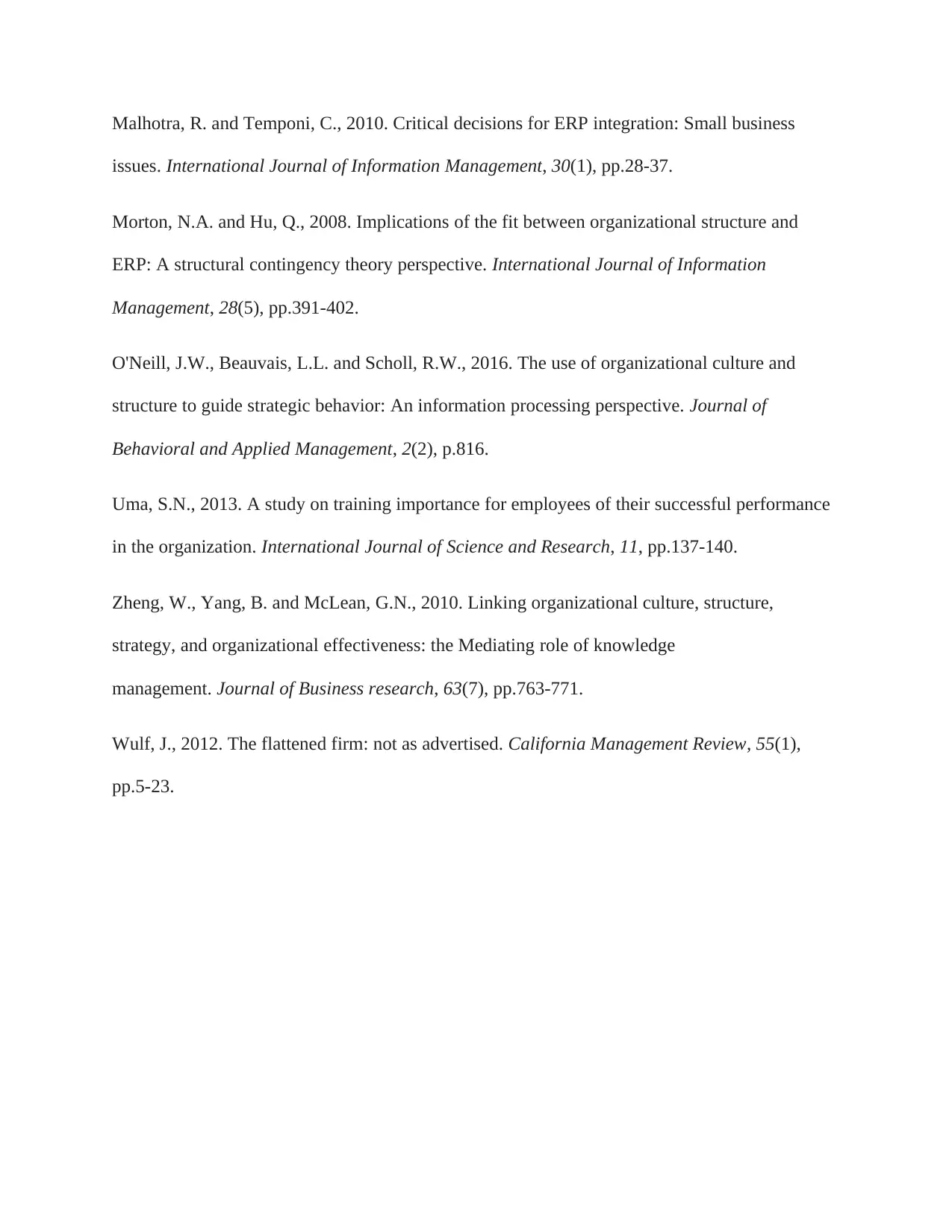
Malhotra, R. and Temponi, C., 2010. Critical decisions for ERP integration: Small business
issues. International Journal of Information Management, 30(1), pp.28-37.
Morton, N.A. and Hu, Q., 2008. Implications of the fit between organizational structure and
ERP: A structural contingency theory perspective. International Journal of Information
Management, 28(5), pp.391-402.
O'Neill, J.W., Beauvais, L.L. and Scholl, R.W., 2016. The use of organizational culture and
structure to guide strategic behavior: An information processing perspective. Journal of
Behavioral and Applied Management, 2(2), p.816.
Uma, S.N., 2013. A study on training importance for employees of their successful performance
in the organization. International Journal of Science and Research, 11, pp.137-140.
Zheng, W., Yang, B. and McLean, G.N., 2010. Linking organizational culture, structure,
strategy, and organizational effectiveness: the Mediating role of knowledge
management. Journal of Business research, 63(7), pp.763-771.
Wulf, J., 2012. The flattened firm: not as advertised. California Management Review, 55(1),
pp.5-23.
issues. International Journal of Information Management, 30(1), pp.28-37.
Morton, N.A. and Hu, Q., 2008. Implications of the fit between organizational structure and
ERP: A structural contingency theory perspective. International Journal of Information
Management, 28(5), pp.391-402.
O'Neill, J.W., Beauvais, L.L. and Scholl, R.W., 2016. The use of organizational culture and
structure to guide strategic behavior: An information processing perspective. Journal of
Behavioral and Applied Management, 2(2), p.816.
Uma, S.N., 2013. A study on training importance for employees of their successful performance
in the organization. International Journal of Science and Research, 11, pp.137-140.
Zheng, W., Yang, B. and McLean, G.N., 2010. Linking organizational culture, structure,
strategy, and organizational effectiveness: the Mediating role of knowledge
management. Journal of Business research, 63(7), pp.763-771.
Wulf, J., 2012. The flattened firm: not as advertised. California Management Review, 55(1),
pp.5-23.
⊘ This is a preview!⊘
Do you want full access?
Subscribe today to unlock all pages.

Trusted by 1+ million students worldwide
1 out of 12
Related Documents
Your All-in-One AI-Powered Toolkit for Academic Success.
+13062052269
info@desklib.com
Available 24*7 on WhatsApp / Email
![[object Object]](/_next/static/media/star-bottom.7253800d.svg)
Unlock your academic potential
Copyright © 2020–2025 A2Z Services. All Rights Reserved. Developed and managed by ZUCOL.





